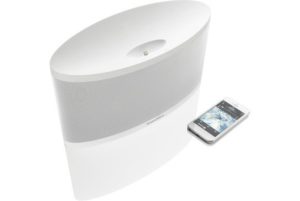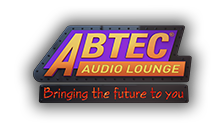
Bowers & Wilkins’s $400 Z2 is the apparent successor to the company’s Zeppelin Mini, but instead of a 30-pin dock connector, the Z2 features a Lightning-connector dock and AirPlay wireless streaming. Supporting the latest iPhone, iPod touch, and iPod nano models, the Z2 is available in black or white glass-filled ABS. (The black model is available now; the white model won’t ship until June.)
Like the earlier Zeppelin mini, the Z2 measures 7.1 inches tall, 12.6 inches wide, and 3.9 inches deep; it weighs 5.7 pounds. The speaker looks cool, with a distinctively angled round top, and a pleasantly curved recessed area surrounding the Lightning dock itself. On the bottom right of the speaker sits a single LED, which glows red when the unit is asleep, glows pinkish when it’s connected to Wi-Fi, and indicates other statuses during setup and troubleshooting.
In front of the Lightning dock sit two tiny, slightly raised, capacitative buttons for controlling the system’s volume. These buttons are some of the first touch-sensitive speaker buttons I haven’t hated: Because you can see and feel them, there’s never any doubt that you’re pushing in the right spot, and the buttons themselves are responsive.
On the back of the Z2, you’ll find an ethernet port, a reset button, a 1/8-inch (3.5mm) auxiliary-input jack (for connecting a wired audio source), and a connector for the Z2’s power adapter.
My iPhone 5 connected to the Z2’s Lightning-connector dock easily, and the phone felt secure while sitting there: While the phone does wiggle a bit, there’s much less play, and the dock connector feels much less fragile, than with 30-pin connector of old.
Getting the Z2 on my network wasn’t too painful using the free Bowers & Wilkins Control app for iOS. The process isn’t as elegant as with some other speakers—the best can import your iOS device’s Wi-Fi configuration when you connect the speaker to the device via USB. Instead, the Z2 relies on the older approach of connecting your device to an ad-hoc wireless network created by the speaker, and then using either the B&W app or your Web browser to configure the speaker’s networking settings..
The speaker ships with a small, black, plastic remote. That remote sports buttons for power, volume control, play/pause, previous, next, and input selection. You’ll need that last button to switch the Z2 between AirPlay, the Lightning dock, and the auxiliary input, so you don’t want to lose the remote—there’s no way to switch the input on the speaker itself.
Inside the Z2 are dual (left and right) 3.5-inch full-range drivers, along with a pair of 20-Watt amplifiers. I listened to my docked iPhone 5 and to various sources streaming via AirPlay, and, like B&W’s A7 AirPlay speaker, the Z2 sounded great. Regardless of what kind of music I played, the speaker offered exceptional clarity—for both midrange and treble frequencies—and fine bass presence. Bass performance, though, is the Z2’s weakest spot thanks to the system’s compact size and small drivers. There’s a bass port on the back of the speaker, but there’s no bass driver or subwoofer—the result is that bass is merely present, not powerful. That said, the Z2 generates big, loud, impressive sound.
Bottom line
Bowers & Wilkins’s $800 A7 remains the priciest AirPlay speaker I’ve tested, and it sounds exceptional. The company’s Z2 costs half as much, but it still sounds very, very good. While the Z2 can’t rival the A7’s sound, it’s far more affordable, it’s considerably smaller, and it offers a Lightning dock for wired playback and device charging. I haven’t tested a better AirPlay speaker for this price.
Read more at: https://www.macworld.com/article/2035806/review-bandws-z2-is-an-impressive-airplay-speaker-and-iphone-dock.html
Where to buy B&W Z2: https://www.abtec.co.nz/product-search.php?keyword=Bowers+%26+Wilkins+Z2+&category=&brand=&search=

